Introduction: In this article, Scott Phillips turns to old newspaper articles to teach his grandsons about some of the occupations their ancestors once had. Scott is a genealogical historian and owner of Onward To Our Past® genealogy services.
From census forms to marriage records, and from birth records to death certificates, many of our ancestors are identified by their occupational jobs.
Whenever I discover an ancestor’s occupation I always make certain that I add this information to my online family tree. Recently I was talking with our young grandsons about our family history, and made mention of a couple of the old occupations our ancestors held. Many of these old job titles, not surprisingly, were very foreign concepts to them. To help them out and enhance my never-ending attempt to capture the tapestry that is our family, together we opened up GenealogyBank.com for some help understanding what our relatives did for a living.
Old Occupation 1: Lamplighter
First we looked up the occupation of a cousin from Cleveland, Ohio, who was a lamplighter. For some reason I have always conjured up rather romantic visions of lamplighters. Reality set in as I read the first article I found, from an 1894 New York newspaper.
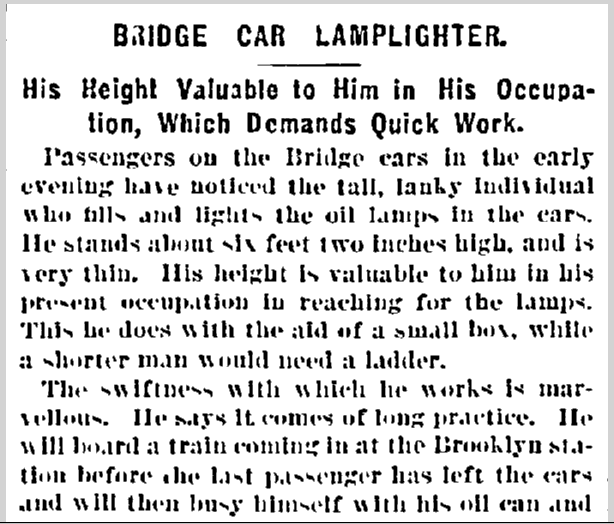
This article explained how relentless and demanding this lamplighter’s job was, as he had to light every lamp on a train—only to then move immediately to the next train and its lamps.
Then I came upon an article from a 1916 Rhode Island newspaper.
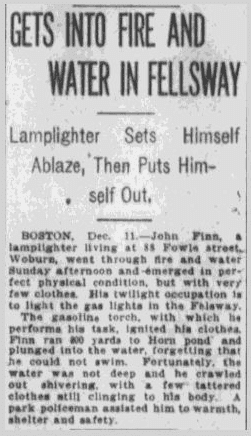
This historical newspaper article detailed the unfortunate experience of one John Finn, a lamplighter who accidently lighted his own clothes on fire, then jumped into a nearby pond to save himself! We chuckled and quickly decided that the work of a lamplighter was far from a romantic job!
Old Occupation 2: Cooper
The next old occupation that caught our attention was “cooper.” Although I knew that many of our Bohemian ancestors were coopers, this was a totally unknown job to our grandsons. While I explained that a cooper was a person who made barrels, we looked further. Our first discovery about this old job was an article from an 1898 Ohio newspaper.
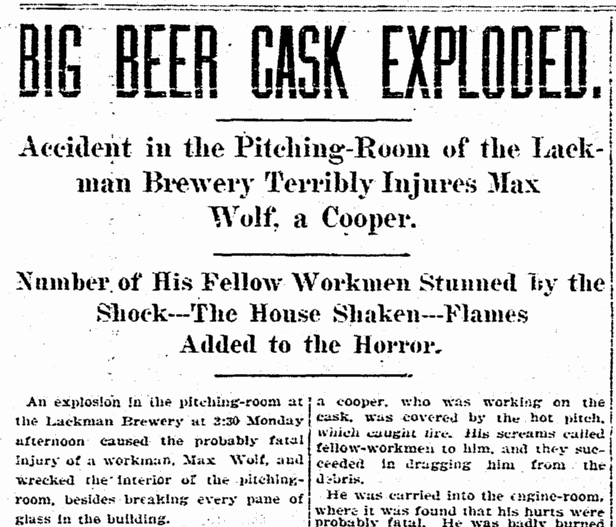
This story explained the unfortunate injury to one Max Wolf, a cooper who was working on a huge beer barrel with a 2,200-gallon capacity that exploded.
Next our occupational search brought us to an article from an 1880 Ohio newspaper.
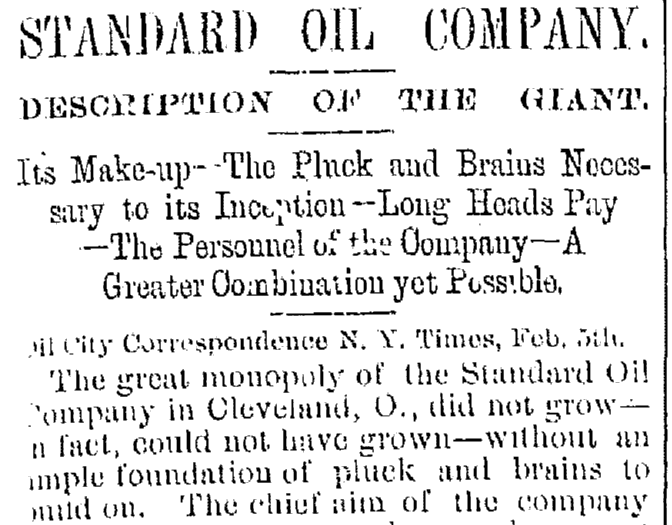
This 1800s news article contained an explanation of the cooper shop of the Standard Oil Company’s refinery, its “millions of oak staves,” its employment of “an army of men,” and the blue barrels with white tops coming out of the shop for hours on end.
Old Occupation 3: Grave Digger
We then moved on to another old family occupation: grave digger. Our first discovery on this occupation was an article from a 1906 Indiana newspaper.
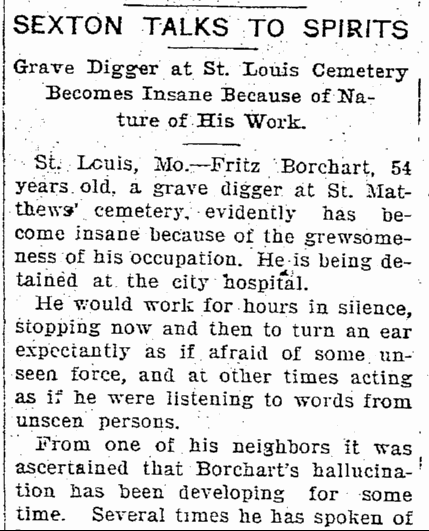
The news article’s subtitle stated: “Grave Digger at St. Louis Cemetery Becomes Insane Because of Nature of His Work.” Needless to say, that was enough to have us move on to something different.
Old Occupation 4: Miners
At this point I proposed we look into a more recent occupation of a family member, and suggested that we look up “miners.” Our first article was from an 1894 New York newspaper—but it wasn’t any more cheerful than the previous article.
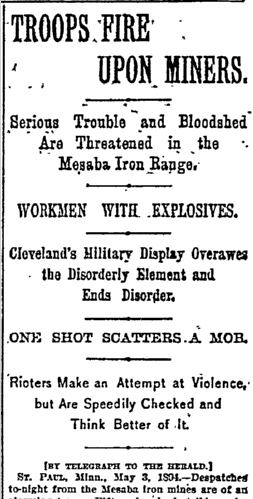
While this one sparked my interest, I decided we might need something a bit lighter for the boys. Soon we were scanning articles from the mines of Ishpeming, Michigan, to Hibbing, Minnesota—mines where family members worked over the generations to extract riches from the earth—that were more upbeat.
It wasn’t long before our conversation turned to the need for a good education to get a good job—and I realized that while we were looking at old family jobs, a positive impact had been made on these young men!
So tell me please. What are some of the different occupations in your family tree?
You might also be interested in these previous blog articles about early American jobs:

We had wire workers (from Slovakia who came to New York City) who mended broken bowls with flour glue to hold them while wire was wrapped around them in an intricate design that would force the pieces together and the bowl would again hold water or liquids.
Stephen, that is very cool! What a wonderful story to know about your ancestors! What artisans they must have been to be able to fix bowls like that. Yet another piece of history I’d love to be able to witness!
Thanks for sharing!
Scott
My great grandfather is listed in the 1870 census as a teamster in North Carolina. My Uncle said he was hauling tobacco. Is that accurate?
Mae, That very well could be accurate. The original ‘teamsters’ were those (usually) fellows who owned a team (horses, mules, etc) and drove the ‘team’ to haul goods. Not surprised that he could be hauling tobacco in those days in North Carolina.
Very neat to have ‘the rest of the story’ from your uncle to augment the Census!
Thank you so much for sharing!
Scott
My Maternal Grandfather was brought to US from England to do some lace work in a factory or so I have always been told. His family in England were all laceworkers. Exactly what would he do? Is there evidence of this in NE US?
Jane,
Yes, there was a lace industry in New England. I have a marvelous book on the lace industry, “The Laces of Ipswich, Massachusetts,” which talks about the lace industry a bit. Also there is a wonderful lace museum in Sunnyvale, Ca., that I understand is worth a visit!
I have a number of tatters in our family tree as well. Thanks for sharing! I often wish I could tat!
Scott
My gGrandfather was a goldbeater. He would spend all day beating down the gold into little sheets that would be used as gold leaf to cover/emboss items. My grandmother used to talk about how he would come home from work covered in gold flecks.
I would like to know about any Ellis reletives living in the East.
My paternal grandfather held an occupation as a “candler” which translated into one who looked held up each egg individually in front of the light from a candle to ascertain whether the egg was “good” or “bad”
My grandfather, Henry Shepard worked for Standard Oil Co. of N. J. & I believe was born in Perth, N. Jersey. In 1912 give or take 2 yrs. he went to Liverpool, England. He returned back to Framingham, Massachusetts married & had a son, walter F. shepard. Henry Shepard finished his marriage to Anastasia, my grandmother. Where did he go? Did he go to another state and start a new life? maureen.shepard@yahoo.ie
Richard- GenealogyBank.com has a large collection of Eastern US newspapers. Searching newspapers can give you a wealth of information about your ancestors by just putting in the last name of Ellis and a date range you are searching with the states you would like to search.
My GGGrandfather arrived to the U.S. as a child between 1850-51 from Genoa (Northern Italy). Prior to his arrival, he fought with Garibaldi´s army in the battle of Goito and Novara and arrived to the U.S. escaping the Crimea War of 1849-50. He was well known and respected by Prof. Felix Foresti and General Avezzana, also prominent Italian exiles in New York. He attended medical school at UVM in Vermont and went by the name of Raphael Columbo. J.K. Converse, Principal at Burlington Female Seminary where he taught Italian and Spanish, referred to him as Prof. Columbo and Signor Columbo. I still need to find out his port of entry to the U.S. If anyone knows where I can look for such information, please leave me a note. Thanks!
My father worked with a building construction group with a man named “Mr. Butrile.” He was from Lagrange, Georgia. They built a church in Rockart, Georgia, back in the 1960s. I do not know the denomination. I would like to know if the church still stands, and a picture of it if possible.
RICHARD FREDERICK SMITH, born 6-4-1917 in Coweta Co., GA. Thanks.
Joan — You have a few options in doing your search. Newspapers can be a great way to find churches. They often put their address and times of service in the newspaper. It was common to have an advertisement for churches and pictures of the church. Another good place place to check out is the library in Rockart, Georgia. This could be a wealth of information. They may have a phone book that lists all the churches and has pictures of the churches in the yellow pages. If Rockart has a Historical Society, they may be able to give you this information as well. The last suggestion would be to Google “churches in Rockart”; they sometimes will say “since” such and such a date.